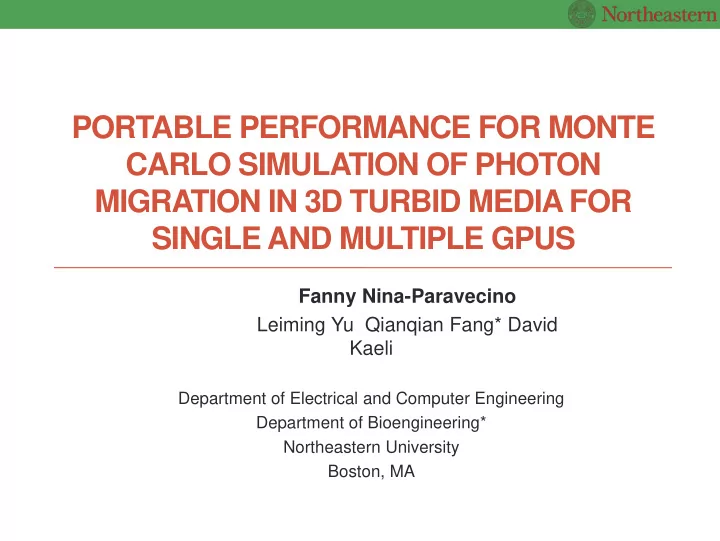

PORTABLE PERFORMANCE FOR MONTE CARLO SIMULATION OF PHOTON MIGRATION IN 3D TURBID MEDIA FOR SINGLE AND MULTIPLE GPUS Fanny Nina-Paravecino Leiming Yu Qianqian Fang* David Kaeli Department of Electrical and Computer Engineering Department of Bioengineering* Northeastern University Boston, MA
Outline • Portable Performance Monte Carlo Extreme (MCX) • MCX in CUDA • Persistent Threads in MCX • Portable Performance MCX • MCX on multiple GPUs • Linear Performance • Linear Programming Model • Performance Results
PORTABLE PERFORMANCE MCX Photons initialization 3D voxelated media
Monte Carlo Extreme (MCX) in CUDA • Estimates the 3D light (fluence) distribution by simulating a large number of independent photons • Most accurate algorithm for a wide ranges of optical properties, including low-scattering/voids, high absorption and short source-detector separation • Computationally intensive, so a great target for GPU acceleration • Widely adopted for bio-optical imaging applications: • Optical brain functional imaging • Fluorescence imaging of small animals for drug development • Gold stand for validating new optical imaging instrumentation designs and algorithms
MCX in CUDA Simulation of photon transport inside human brain Imaging of bone marrow in the tibia Imaging of a complex mouse model using Monte Carlo simulations
MCX in CUDA [1] … Loop of repetitions Thread i+1 Thread i Seed GPU RNG Start Launch a photon with CPU RNG Compute the scattering length Global Move photo one Memor voxel y Compute attenuation based on absorption Compute a scattering Accumu. Probability direction Repetition to the volume vector complete? n y y Scattering Exceeds ends ? time gate? Retrieve solution n End of y n Total move Terminate Normalize & save or photon # simulatio thread reached? solution n CPU GPU [1] Q. Fang and D. A. Boas. "Monte Carlo simulation of photon migration in 3D turbid media accelerated by graphics processing units." Optics express 17.22 (2009): 20178-20190.
Persistent Threads (PT) in MCX • PT kernels alter the notion of a virtual thread lifetime, treating those threads as physical hardware threads • PT kernels provide a view that threads are active for the entire duration of the kernel • We schedule only as many threads as the GPU SMs can concurrently run • The threads remain active until end of kernel execution Thread Block CUDA Grid Structure Grid …
Persistent Threads (PT) in MCX • A PT kernel bypasses the hardware scheduler, relying on a work queue to schedule blocks • A PT kernel checks the queue for more work and continues doing so until no work is left • PT MCX works on a FIFO blocking queue Blocks Back Front Shared Multiprocessor Enqueue Queue
Portable Performance for MCX • Fermi Kepler Maxwell MaxThreadBlocks 8 16 32 /Multiprocessor MaxThreads/Multi 1536 2048 2058 processor Multiprocessors 16 14 22 (MP) CUDA cores / MP 32 192 128 # threadsPerBlock = (MaxThread/MP)/(MaxThreadBlocks/MP) # blocks = # threadsPerBlock * (MaxThreadBlocks/MP) * MP
Portable Performance MCX - Results Kepler GK110 Baseline Improved Code Maxwell 980Ti Baseline Improved Code 32 128 32 128 ThreadsPerBlock ThreadsPerBlock 86,016 28,672 90,112 45,056 # Total Threads # Total Threads 2688 224 2816 352 # Blocks # Blocks Performance Performance 2383 2887 13,369 15,015 (Photons/ms) (Photons/ms) 1.0 1.21 1.0 1.12 Speedup Speedup Baseline Code Improved 1.3 1.2 1.1 1.0 0.9 Speedup 0.8 0.7 0.6 0.5 0.4 0.3 0.2 0.1 0.0 Kepler GK110 Maxwell 980Ti
MCX ON MULTIPLE GPUS
Linear Programming Model • Given n devices: D 1 , D 2 , … D n • Given linear performance for each device • Given the performance for 10 Million photons and 100 Millions for each device • We can obtain the linear equation for each device as follow: y 1 = b 1 + ( x 1 - 1) a 1 + C 1 Device 1 f1: y 2 = b 2 + ( x 2 - 1) a 2 + C 2 Device 2 f2: . . . . . . y n = b n + ( x n - 1) a n + C n Device n f3:
Performance Results • We evaluated our Linear Programming on Linear Model ( LPLM ) scheme for two different configurations of NVIDIA devices • The resulting partition of the workload achieves an average 8% speedup over the baseline 2100 Baseline LPLM 2050 Photos/ms 2000 1950 1900 1850 1800 1750 10M 50M 100M 10M 50M 100M GTX980+GT730 GTX980+GT730+GTX580 # Photons
Summary • We have improved the performance of MCX across a range of NVIDIA GPU architectures • We have showed how to exploit Persistent Thread kernel to automatically tune MCX kernel • We developed a linear programming model to find the best partition to run MCX on multiple GPUs • We improved performance of MCX run on multiple NVIDIA GPUs, including Kepler and Maxwell • We obtained an 8% speedup when using automatic partitioning
Future Work • PT MCX • The queue of blocks can either can be static (know at compile time) or dynamic (generated at runtime), and can be used to control the order, location, and the timing of each block • Instrumentation of MCX • Leverage SASSI to instrument MCX and better characterize the behavior of a kernel to guide auto-tuning • MCX on Multiple GPUs • Evaluate our partitioning optimization for multiple devices
THANK YOU! Questions?
Recommend
More recommend